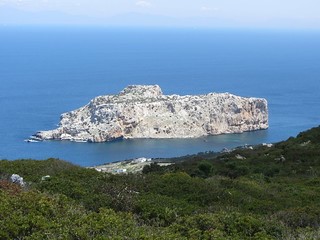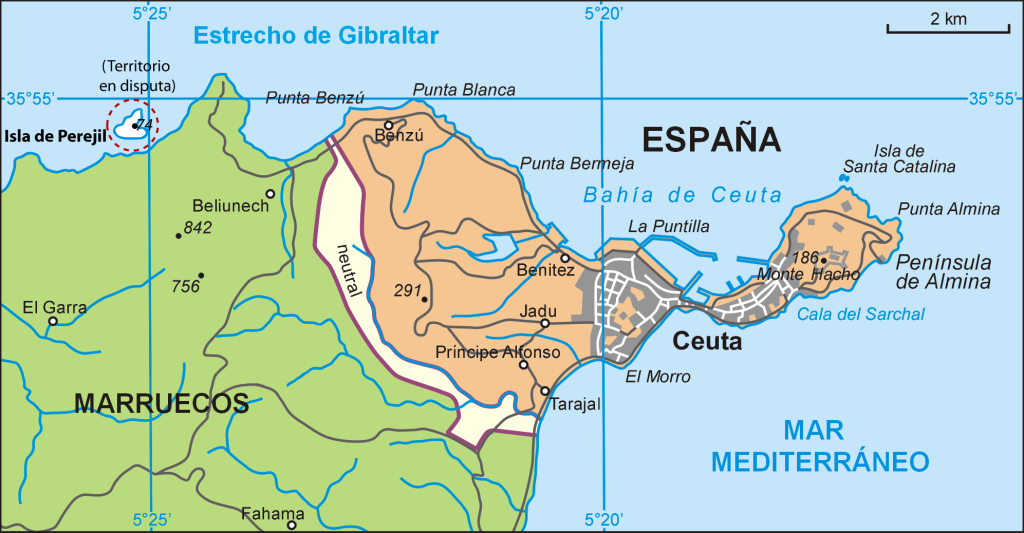
Grove Koger
When sovereignty and national pride are involved, even the tiniest speck of land—the smallest rock—can take on exaggerated importance.
That’s the lesson of Perejil Island, or Isla Perejil (as it’s known in Spain), or Jazirat Laila (as it’s known in Morocco). The word “perejil,” in case you’re wondering, is Spanish for “parsley,” a wild variety of which apparently grows there.
Perejil is about a quarter of a square mile in size, and although it lies only 270 yards from the African mainland, it’s been Spanish territory for nearly four hundred years. Spain’s Iberian neighbor, Portugal, took possession of the rocky islet in 1415 from what’s since become Morocco. At the time, Spain and Portugal were ruled by a single sovereign, although, a little confusingly, they remained separate countries. That ended in 1640, when this Iberian Union, as it was known, came to an end. One of the upshots of the break was that Perejil, along with Ceuta, a port on the nearby coast of Africa that Portugal had also seized in 1415, eventually became Spanish. Are you with me so far?

In any case, Perejil, which is administered from Ceuta, has no permanent human inhabitants, although in the opening years of the twenty-first century a Moroccan woman, Rajma Lachili, was routinely grazing her goats on the islet and smugglers and refugees were making occasional use of it. Whether the latter situation was particularly serious in 2002 isn’t clear, but the issue served as a pretext for Morocco to land a dozen soldiers on Perejil on July 11 of that year. They raised the Moroccan flag and set up a rudimentary base, but when Spain protested vehemently, as of course Morocco knew it would, the latter country replaced its soldiers with marines in what was apparently meant to be a conciliatory gesture. However, the switch was to no avail.
On the morning of July 18, Spain’s navy and air force launched Operation Romeo-Sierra, which involved landing a contingent of commandos on the island from helicopters and taking the Moroccans prisoner. Spanish fighter planes provided air cover, while two Spanish patrol boats approached a Moroccan gunboat that was anchored nearby to discourage it from taking action. There were no casualties.

After a blusterous round of charges, counter-charges, and negotiations, Morocco eventually acknowledged Spanish sovereignty over the islet. If anyone profited from the affair, it may have been Ms. Lachili, who had been paid to prepare food for the hapless Moroccan troops. On the other hand, the woman subsequently demanded compensation from Spain for having killed four of her animals. The Spanish defense ministry denied the charge, saying that its men had found the remains of two goats that had apparently been butchered and eaten by the Moroccans. The fate of the other two animals, assuming they had ever actually existed, is unclear.
The squabble over Perejil is just one of several ongoing disputes over territory in the western Mediterranean and the Strait of Gibraltar, many of which have been violent. The British territory of Gibraltar, which shares a border three-fourths of a mile long with Spain, has long been claimed by the latter country and has been the object of protracted sieges and blockades. Spain, on the other hand, possesses two ports and several islets lying along the northern coast of Morocco, including Ceuta and Perejil. These Plazas de Soberanía, as they’re known, have been Spanish territory for centuries and—given the contentious issues I mentioned in my opening paragraph—are likely to remain so for centuries more. Likewise, Gibraltar will almost certainly remain British.
□□□
The photograph at the top of today’s post was taken by Richard White and is reproduced courtesy of Flickr Commons, while the map was produced by Kimdime69 and is reproduced courtesy of Wikimedia Commons. The cover of the Revista Espanola de Historia Militar is scanned from my collection, and features a photograph taken from one of the Eurocopter Cougars involved in the Spanish operation.